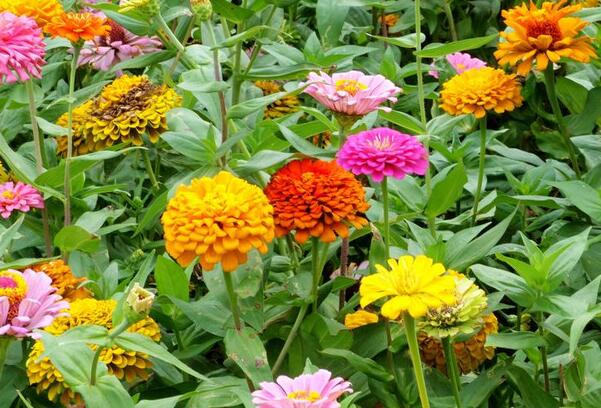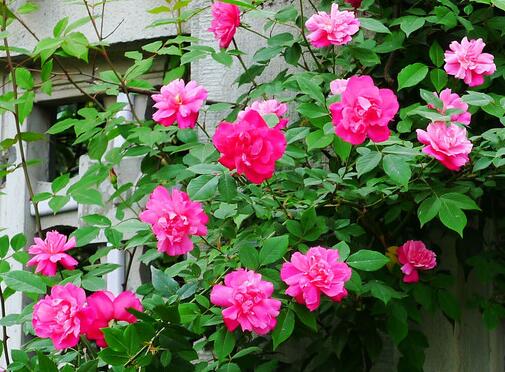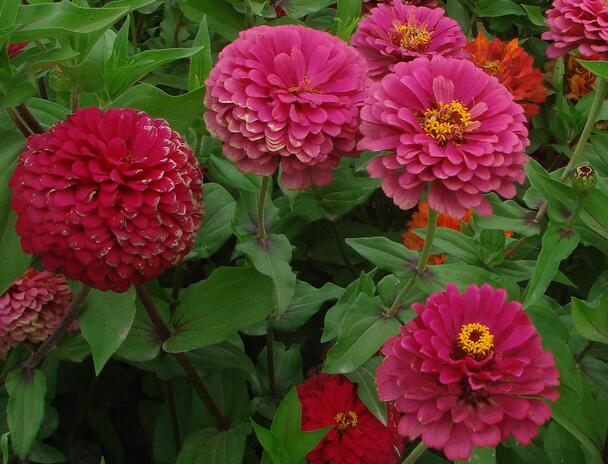Sharing of management techniques for sowing, cultivation and management of zinnia
Hundred-day grass is a hundred-day grass, annual herbs, strong sex, like warmth, not resistant to cold, like light, more tolerant to drought. The suitable temperature for germination is 22-25 ℃. When sowing, it should be slightly covered with soil and placed in a place away from light, and should be transplanted immediately after the true leaves grow. When will the zinnia be sown?

When will the zinnia be sown:
In North China, the seedlings can be sowed in the open field in the middle of April, and the seedlings can be produced 7 days after sowing. If the seeds are sown too early and the temperature drops below 15 degrees Celsius after emergence, the seedlings will stop growing and will always grow poorly in the future. Transplant once when the seedling height is 5cm to 8cm.
It was moved to the flower bed in late May.
In order to expand propagation, you can cut side branches and cuttings in mid-June, shade and prevent the cuttings after cutting, otherwise the cuttings are easy to rot.
If you want to watch the flowers on May Day, you should plant them in the greenhouse in early February, plant "No. 3 bucket" pot in late March, replace it in "No.1 catch" pot in early April, and plant it in late April.
When cultivated in the garden, the plant spacing is 10 cm to 20 cm, and when planted in flower beds, the plant spacing is 50 cm for high seedlings, 40 cm for middle seedlings and 30 cm c for preventative seedlings.
The main branch of Artemisia mandshurica blossoms at first, then the lateral branches grow node by node and blossom one after another at the top of the lateral branches, so the management of fertilizer and water should be strengthened to improve the quality of the flower head. When the blossom stops at the height of summer, you should stop topdressing, but keep the soil moist to prevent withering and death, and be able to jointing and blooming after autumn.
Dwarf seedlings can be cultivated in pots, but the hearts should be picked repeatedly to promote the sprouting of more lateral branches, thus forming low, plump plants.
The seeds of rice seedlings can only be planted on the ground. In order to prevent the branches from being broken and lodging due to the strong wind, it is best to plant them in pieces.
Cultivation and management techniques of zinnia:
Although the height of zinnia varieties is different, it is generally controlled between 20-30cm. It is not only suitable for use in flower beds and flower borders, but also an excellent material in art. Sowing and raising seedlings: about 125,300,300 and 1500 seeds per gram of large flower type, medium flower type and multi-flower type respectively. The largest amount is used in flower beds, flower decorations and flower mirrors during the National Day. The sowing time is generally controlled from June to July, and autumn sowing is also carried out, but due to the influence of temperature and other factors, it has a certain impact on flower color and plant shape, so autumn sowing is generally not used. The sowing medium adopts relatively loose artificial medium, such as bed sowing and disk sowing, and burrowing plate can also be used to raise seedlings under some conditions. the medium requires a pH value of 5.8-6.2 and an EC value of 0.75. after disinfection, the sowing medium can be kept at 22-24 ℃ and the seedlings will emerge in 3-5 days.
The first stage:
Three days after sowing, the radicle is on display, the degree of wetness of the medium should be relatively dry, too moist, easy to cause seed rot. However, it is very important to maintain moisture and sufficient oxygen around the seeds at this stage, so it is very beneficial to seed germination to cover with a thin layer of coarse vermiculite or loose ridge ash after sowing. Open seedlings must be covered with shade nets to ensure humidity and lower temperature (if sowing in the germination chamber, appropriate supplementary light can be given). No fertilizer is needed at this stage.
The second stage:
Keep the soil relatively moist, neither too wet nor too dry, too wet can easily cause disease, too dry will lead to wilting of seedlings. At this time, the main root grows to 1-2cm, the cotyledons expand, and the first pair of true leaves begin to grow, and the seedlings can gradually see light. Fertilization can be started, generally using 0.05% urea or 50ppm20-10-20 water-soluble fertilizer, N can promote vegetative growth.
The third stage:
When the seedlings enter the rapid growth period, the water management should be strengthened and the circulation process from dry to wet to dry should be carried out, which is beneficial to the root growth of seedlings and can also avoid overgrowth. At this stage, attention should be paid to pest control, 0.1% urea or compound fertilizer can be applied properly, and the proportion of N-P-K can be 15-15-15 (or according to the market supply, the content of N and K can be slightly higher. P content can be on the low side. If the conditions permit, the temperature of the medium and environment should be reduced to about 20 ℃, but it is difficult to control the temperature when sowing under the condition of bed sowing, and the full light environment is needed at this stage, otherwise it is easy to cause seedlings to grow. According to the growth trend of the seedling stage, the moisture should be controlled properly. Pay attention to the ventilation of the environment to prevent diseases. Spray chlorothalonil or methyl topiramate every other week or so. If overgrowth occurs at this stage, B9 should be sprayed immediately to control the height.
The fourth stage:
The root system has been well formed, and when there are 3-4 pairs of true leaves, overgrowth occurs. B9 should be sprayed immediately to control the height. The requirements of temperature and humidity are the same as those of the third stage. After the seedling refining stage, it is ready to be transplanted into the pot.
Transplant / upper basin: when there are 2-3 pairs of true leaves, they can be transplanted into the pot; if they are seeded on the plate or in the bed, they can also be put on the pot directly when there are 3-4 pairs of real leaves. According to the requirements of plant height and plant diameter, the nutrition bowl of 12 × 13 is generally used, which can be put in place at one time, and there is no need to change the basin. The root system of hole-plate seedlings is less damaged and the transplant is easy to survive; for open seedlings, more mud should be carried out as much as possible, and the transplanting time should be carried out in the evening or cloudy days to improve the survival rate.
Light regulation: zinnia is a positive plant, growth and flowering require sufficient sunlight, lack of sunlight is easy to produce stem node length, affecting the ornamental effect. There is no need for shade during the whole growing period after potting.
Temperature control: zinnia likes temperature, but under the extremely hot summer conditions, the growth potential is slightly weaker, the flowering effect is not ideal, and the optimum temperature for growth and flowering is 15-20 ℃. The sowing date of zinnia is controlled in summer to prepare flowers for National Day. During the growth period, the high temperature above 35 ℃ generally will not affect the growth.
Cultivation management: when there are too many Rain Water in the rainy season, it is easy to cause excessive elongation of internodes, so attention should be paid to eliminating stagnant water and spraying B9 at an appropriate time; long sunny and little rain in summer, too dry, easy to weaken the growth potential and affect the color of flowers, water and fertilizer management should be paid attention to at this time. During the whole growth period, proper water control and dry humidity between basin and soil are beneficial to root development and height control. Potted fertilizer is usually applied once every 7-10 days, and topdressing can be carried out depending on the growth. 0.2% urea and compound fertilizer are used at intervals, and urea is stopped one month later. According to the growth condition after flowering, the interval of topdressing application of compound fertilizer can be prolonged appropriately. Because the lateral branches of zinnia have the habit of terminal bud flowering, if the natural growth is not controlled, the flowering site will be higher and higher, affecting the beautiful plant shape, timely coring before and after transplanting and controlling the plant shape. In general, 2-3 pairs of true leaves are retained. Hundred-day grass can be pruned, but it grows poorly after pruning, so this method is generally not used.
Diseases and insect pests: the main diseases of zinnia are: seedling stage quenching disease, growing period bacterial wilt disease, stem rot disease, leaf spot disease; insect pests are: night moth, red spider, cabbage worm and so on.
Technical regulations for cultivation and management of Hercules
L. Parcel selection
"Dazhi" is a new generation of sweet sorghum intraspecific hybrid variety. It has three adaptive characteristics of drought resistance, waterlogging resistance and saline-alkali tolerance. Therefore, it has the ability to adapt to all kinds of soil. Therefore, the requirements for the selection of land plots are not + strict. However, in order to achieve high yield, the selection of good cultivated land can significantly improve the quality and yield. In order to exert the genetic potential of the variety. -sandy loam, clay loam or weakly acidic soil can be planted, but rational fertilization should be paid attention to in barren soil. Farmers can grow in front of the house, behind the courtyard, by the pond or on mountain terraces. It should be noted that in the cold northeast region, some rice fields are cold in early spring, the soil temperature at the bottom of the field rises very late, and the soil permeability is poor, so planting in this land is not recommended, but normal growth is not affected in other provinces.
2. Land preparation
If you want to get a high yield, you need intensive cultivation. Before soil preparation, lOOO-l5OO kg farm manure per mu was used as base fertilizer. Just break the fine ploughing.
3. Sowing date
Sweet sorghum "Dazhi" likes warmth and is sensitive to low temperature and frost damage. The grown-up plants have definite cold resistance, and the seedlings are easy to suffer when the seedlings are at 0 degrees Celsius, so the late spring cold should be prevented in the northeast. Under the same circumstances, seeds begin to germinate at 7-8 degrees Celsius, but most of them are sown at temperatures above 12 degrees Celsius. The growth period requires a higher temperature, and the suitable growth temperature is from 18 degrees Celsius to 30 degrees Celsius. It is recommended to sow seeds at L5 degrees Celsius in cold areas of northeast China, while sowing at L2 degrees Celsius in other areas such as Jiangsu, Gansu and Henan. Sowing prematurely, due to low soil temperature and high humidity, it is easy to cause seed rot, that is, the so-called "powder seed". According to the needs of production, the seeds can also be sown in stages to prolong the utilization period. Most of the Northeast China is sown from mid-April to early May in Inner Mongolia, Gansu, * * and other places. Generally speaking, sowing marshmallows is 1 to 2 weeks later than corn. When to sow, sow and propagate / sow in March and blossom in June.
Zinnia, although it is grass, but we all know that it will blossom and bear fruit, and its flowers are very beautiful. With regard to the breeding method of zinnia, because it will bear fruit, if there are seeds, you can naturally sow and reproduce. When will zinnia be sown? Next, the editor will introduce the methods of sowing and propagation of zinnia. Friends who want to raise more pots of zinnia must have a look.
When will the hundred-day grass be sown, from March to June?
When to sow a hundred-day grass is actually determined according to the time of flowering, generally speaking, sowing 2-3 months before flowering. And because the flowering period of the hundred-day grass is from June to October, the sowing time of the hundred-day grass is usually carried out in March-June of the Spring Festival.
2. Sowing and propagation methods of zinnia
1. Seed / soil disinfection
Before sowing and breeding, the soil and seeds should be strictly disinfected to prevent diseases and insect pests during the growing period. Among them, the seeds were disinfected and soaked in 1% potassium permanganate solution for 30 minutes.
Sowing medium: 2 parts of rotten leaf soil, 1 part of river sand, 2 parts of peat and 2 parts of perlite. Soil disinfection can be disinfected with 0.05% potassium permanganate or 1000 times formaldehyde. In addition, high temperature fumigation can also be used to kill germs, pests and grass species.
2. Sowing method
It is understood that the life span of zinnia seeds is 3 years, and the germination rate is about 60%, so when sowing and propagating, we should choose the full seeds of the previous year to improve the seed germination rate. Seeds can be sowed on demand or unsown, covering about 1 cm of thin soil and watering after sowing.
Note: sowing on demand after the substrate is wet before sowing, zinnia is a photophobic flower seed, and must be covered with vermiculite after sowing.
3. Post-sowing maintenance
After sowing, zinnia can germinate in 3-5 days at a temperature of 21-23 ℃. There is no need for light during the germination period. After germination, the seedling bed keeps 50% of the moisture content of the seedbed, not too wet, so as to avoid rotting roots or sudden falling disease. The seedlings grow 2 leaves and are transplanted once when they are 5-8 cm high.
From planting to flowering, it takes 60-70 days for different varieties, and the suitable growth temperature is 15-30 ℃. Except for the seedlings, they all need sufficient sunlight. According to the culture method of zinnia, 3 parts of humus, 1 part of sawdust and 1 part of river sand can be mixed evenly.
Third, the propagation method of zinnia: cutting
In addition to sowing, the propagation method of zinnia is also cutting, but cutting is not as neat as sowing seedlings. Methods: 10 cm lateral buds were selected for cutting, which generally took root in 5-7 days, and the later cultivation management was the same as sowing, and it could be out of the nursery after 30-45 days. Cutting can be combined with heart-picking dwarfing, as for how to pick the heart of zinnia, there is a detailed introduction, there is no more to say here.
After reading the above contents, we should know when to sow the hundred-day grass. If you want the hundred-day grass to blossom early, sow it in March; if you want the hundred-day grass to blossom late, sow before June. Generally speaking, the zinnia is tenacious, so you might as well try to breed it yourself, it has a great sense of achievement.
- Prev

Can roses be cultured in water? how can they be cultured in water?
Roses are commonly used for ramet, cuttage and striping propagation, which can be carried out in spring, early summer and early autumn. It can also be sown in autumn or in spring after sand storage, and germinate 1-2 months after sowing. As a common woody plant, rose is a relatively large potted plant.
- Next

Propagation, cultivation, maintenance and management of zinnia
Hundred-day grass likes warmth, cold tolerance, sunshine, fear of heat, strong sex, drought tolerance, barren resistance, and avoid continuous cropping. The root is deep and the stem is hard and not easy to lodge. It is suitable to grow in fertile and deep soil. The suitable temperature during the growing period is 15-30C. The following editor brings you the methods of propagation, cultivation, maintenance and management of zinnia.
Related
- Fuxing push coffee new agricultural production and marketing class: lack of small-scale processing plants
- Jujube rice field leisure farm deep ploughing Yilan for five years to create a space for organic food and play
- Nongyu Farm-A trial of organic papaya for brave women with advanced technology
- Four points for attention in the prevention and control of diseases and insect pests of edible fungi
- How to add nutrient solution to Edible Fungi
- Is there any good way to control edible fungus mites?
- Open Inoculation Technology of Edible Fungi
- Is there any clever way to use fertilizer for edible fungus in winter?
- What agents are used to kill the pathogens of edible fungi in the mushroom shed?
- Rapid drying of Edible Fungi

